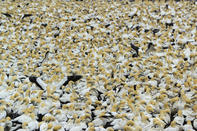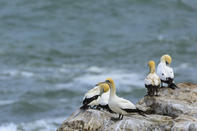Getting to Bird Island
Getting to Bird Island proved difficult. The only landing stage had been destroyed in a storm and repeated cold fronts had meant weeks of delay. But finally there was a weather window and I got the call from SanParks in Port Elizabeth. Come now, or you may miss your chance.
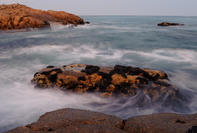
I wasted no time, booked a flight and the next morning boarded a rubber duck bound for Bird. “A good day for it,” said Henvik Visser, section ranger for Bird Island.
We motored away from the moorings and the skipper told us to don life jackets and helmets and hold on very tight. Then he floored the throttles. Both 200 hp Yamaha’s exploded into life and the nose of the Zodiac lifted. I’d never felt anything like it.
“How fast are we going?” I yelled, my eyes watering and cheeks wobbling as they do in those high-G-test films of astronaut training.
“Ag, at full speed we can do 105 kays an hour!” shouted the skipper with an enormous grin.
“Ja, fast enough to catch the poachers,” said Henvik.
Bird Island Lighthouse
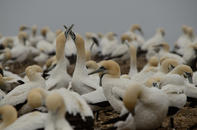
After an hour and a half of high-speed swell surfing, a thin needle stood up out of the ocean: Bird Island Lighthouse. The isle is actually part of a small archipelago that includes Black Rocks, Seal and Stag islets. The skipper took a detour to show us outcrops seething with what looked like outsize maggots. Drawing nearer, I saw that they were in fact Cape fur seals. Corpulent bulls dominated the high ground, while females and pups reclined on the lower ledges.
We entered a shallow channel swept by breaking waves. As anchorages go, it was pretty hairy and the approach was anything but straight forward. Our prow nudged the jetty and we scrambled up. I glanced around: before us lay Bird Island, on the map hardly a pinprick, but a vital breeding colony for Cape gannets, African penguins and Roseate terns. Much of the island’s surface seethed with fowl, as though the very ground were alive.
The Gannetry
Sticking strictly to the paths, Henvik led a walkabout around the isle, not wanting me to wander off on my own and disturb nests or tread on eggs. Angry penguin parents snapped at our heels, warning us away from their chicks. Since the guano was removed from the island for fertilizer (in places it used to be 6 m deep), penguins have struggled with nesting. Traditionally they would have dug burrows in the guano; now they’re often forced to lay their eggs on open ground, exposing them to the elements and marauding kelp gulls. SanParks has introduced concrete pipes cut in half which create ersatz burrows and provide shelter for eggs and chicks.
The gannetry to our left was a dense mass of birds. Looking closely at the melee you could make out behaviour patterns. The bill fencing, sky pointing, awkward take-off postures and stalled flapping in flight above the landing stages. As we explored the isle, Henvik told me about the conservation work. There were five rangers on the island at a time, serving two week stints. Their job entails monitoring, protection and helping with research projects.
Violent Clashes
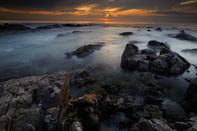
As the shallows around Bird Island are rich in perlemoen, it’s also a target for poachers. There have been some violent clashes as the villains become more brazen in their tactics. The poachers have monitors in Port Elizabeth and Port Alfred that let them know exactly when patrol craft are launched and when the coast is clear. They often operate at night in fast crafts without lights.
“We’ve brought things under control around Bird,” said Henvik. “Actually, we arrested a group of poachers here just the other day. We’re making it hard for them. With the new jetty, we’ll have a boat based on the island. We’ve got R1 rifles, scopes, night vision optics. As long as there are perlemoen on these shores, the war will continue.”
As the Zodiac pulled away from the isle, I was struck by the strong impression this piece of rock had made on me during such a short visit. Far more precious than ever it was in its guano-scraping heyday, Bird Island is a vital sanctuary for a host of Indian Ocean fowl. Its small surface area is an avian metropolis where humans are tolerated as cumbersome gatekeepers. The island’s clear, luminous green waters are patrolled by great whites and ragged-tooth giants, surfed by seals and dolphins and home to penguins that dart beneath the surface in acrobatic underwater flocks.
And it struck me, too, as the lighthouse slid beneath the waves, that this little archipelago was not a place for tourists or even inquisitive visitors like myself. It was a priceless set of jewels that should be locked in its ocean fastness, preserved for posterity as an ecological gift for future generations. It was enough just to know it was there in all its wild, timeless, wave-pounded glory.
By Justin Fox
